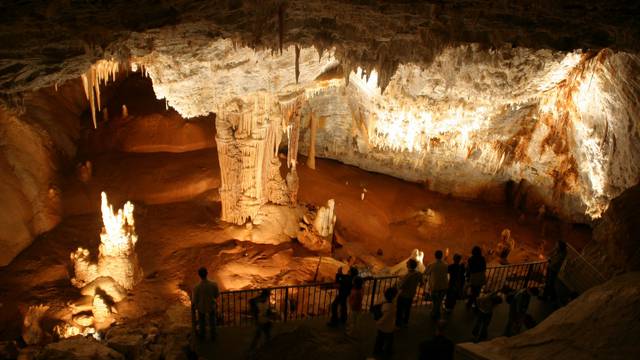History
The name "Hautpoul" has been used since the 10th century. In 1096, Pierre-Raymond d'Hautpoul distinguished himself at the siege of Antioche, during the First Crusade, in Palestine. In the 12th century, the lords of Hautpoul were of the Cathar faith. This Christian conflict was firmly entrenched in the region, and a crusade was launched by Pope Innocent III to eradicate Catharism. Simon de Montfort, the leader of the crusaders, wreaked havoc on the region, but did not succeed in eradicating Catharism from the area, as it was well-established in society. Like Quéribus or Puilaurens, various Cathar clergymen and believers found refuge in Hautpoul during the Crusade, and for a long time afterwards. However, the Inquisition, which was becoming increasingly powerful, put an end to Catharism, and it disappeared in the 14th century. Mazamet, which was built at the foot of the cliffs, replaced Hautpoul. This town contains the Museum of Catharism, which was built to recount the life, faith and destiny of the Occitan Cathars.
Things to explore
As you walk

'Au fil de la laine' (Following the ball of wool)
There has been a textile industry in Mazamet since the Middle Ages, but it did not truly take off until the 18th century. The narrow Arnette valley witnessed a proliferation of fulling mills, which were later replaced by factories. The middle of the 19th century saw the arrival of an important invention: wool pulling. This involved creating 2 raw products from the sheepskin: leather and wool. The development of this intelligent technique, which boosted an already-flourishing textile industry, led to a period of international growth and exceptional prosperity. The two trails recount this extraordinary industrial adventure through information panels dotted throughout the town. You will see private mansions in the Palladian and Neo-Classical styles, and those inspired by Argentinian and Uruguayan 'estancias'. This luxurious homes for the industrial bourgeoisie sit next to the former factories and immerse storerooms with blackened windows.

Hautpoul
3km away from Mazamet, Hautpol has preserved the memory of its origins. This Medieval village on a rocky outcrop has impressive views, which explains its strategic role in the Middle Ages. You can climb to the Virgin's Rock, like the one in Rio de Janeiro, before descending along the only road through the village, meeting craftspeople or stopping in the Tavern. The remains of the castle face into the wind. The 'Chemin des Fontaines' is a mixture of terraces, gardens, fountains, ruins, fields and forest. The last weekend in July is highly anticipated: a Medieval banquet and a fun fair organised by the 'La Roque d'Hautpol' association. And you are invited!
About

The Arnette
Mazamet developed on the banks of the Arnette: the river that has provided wealth to the town. The strength and cleanliness of its water is often praised by the residents of Mazamet, and has become the stuff of legend - you can read about the Legend of the Golden Comb in town. The valley and gorges of the Arnette, once very hectic, have now returned to the tranquillity of Nature. The landscape overlooked by the forest is extremely varied, and includes ravines, valleys, cliffs, gorges, plains and moors. A pair of short-toed snake eagles have chosen this site as their nest, the Montagu's harrier and the hen harrier have found refuge here... Hiking routes through the Arnette, which provide more information about its wildlife, flora and history, can be found in the Mazamet Tourist Office.

Play as a family
With workshops, a games room and 1500 old games inside, and a Fairytale Forest, a Fable Forest and an arboretum outside, the 'Maison du Bois et du Jouet' (House of Wood and Games) is a piece of paradise in the middle of the forest, where you can hear the laughter of adults and children alike. The nearby Lac’Cro Parc de Montagnès offers a world of adventures: 13 trails, 130 workshops and games, 25 zip lines, a tree house and supervised bathing beach... relax, have fun and even take a nap!

Cabrespine and Limousis
Return to the Aude along a path which runs parallel to the Clamoux path: this river flows due south down the slopes of the Pic du Nore and winds through the gorges towards the Orbiel. Along this path is Cabrespine and its spectacular 'gouffre', one of the biggest caves open to the public. Nearby is the Limousis cave; hollowed out by an underground river, it offers a spectacular and mystical journey, where an extraordinary silvery sheen, sounds, lights and much more await... (Find out more).
Wetlands are a habitat between earth and water, and play an important ecological and economical role. In the Montagne Noire in the Aude, there are a large number of different wetlands. Peat bogs are a very specific environment, created when the decomposition of organic material is blocked, creating peat. The wetland plains with water-retaining clay soil, and the wetland woods, marshes and pools soften the climatic excesses of the region, which can oscillate between droughts and floods. They also play an important role in preserving biodiversity. The flora and fauna here are very specific and often unique. Please respect these precious and fragile habitats on your hikes.

























